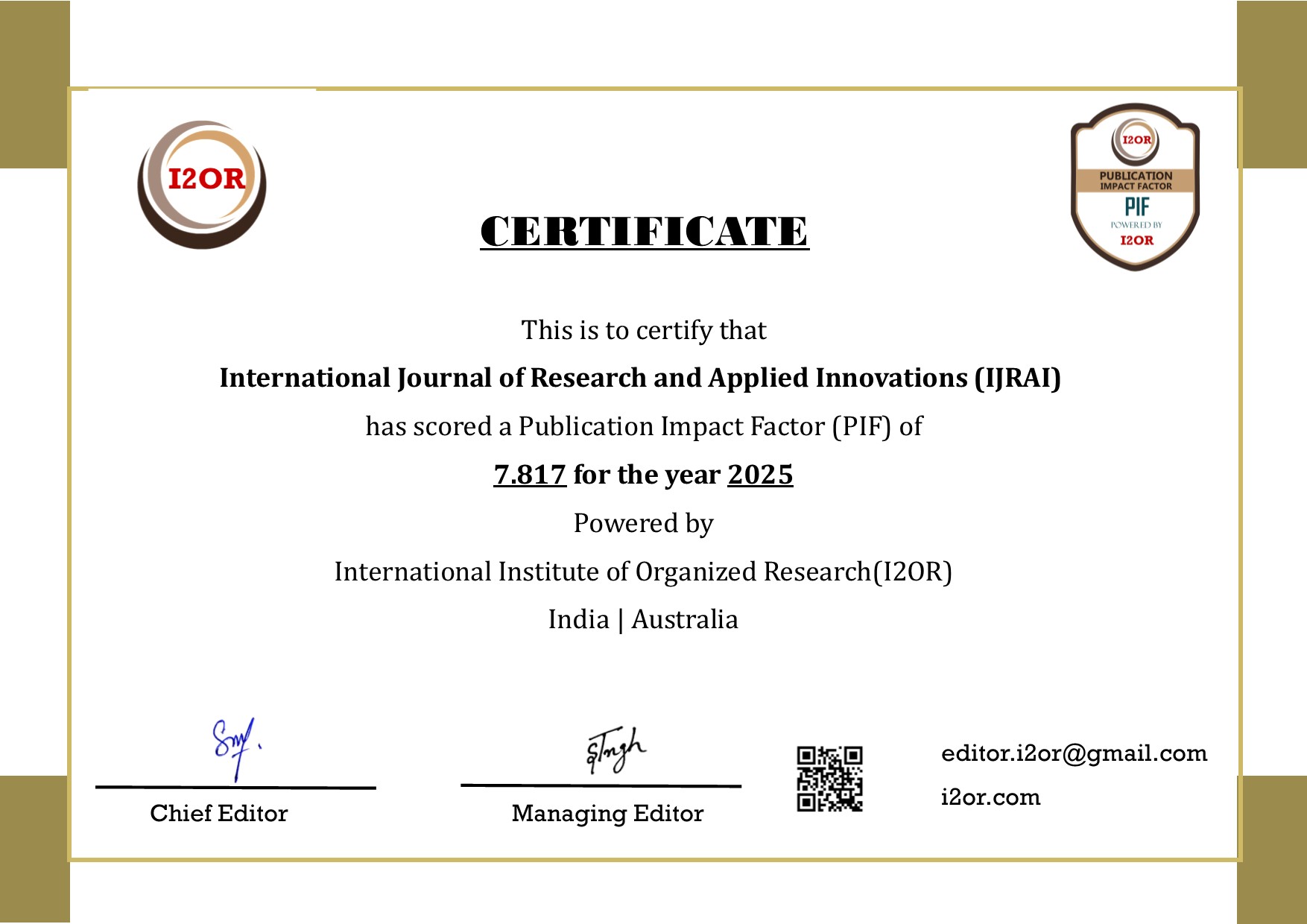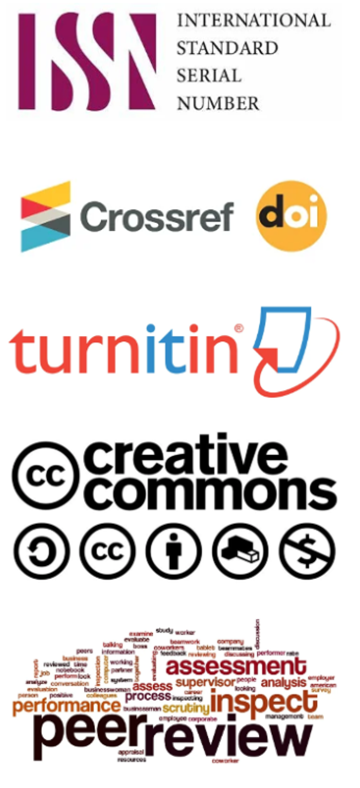Artificial Intelligence for Autonomous Infrastructure: A Deep Reinforcement Learning Approach to Datacenter Operations
DOI:
https://doi.org/10.15662/gn84s304Keywords:
Deep Reinforcement Learning, Intelligent Datacenter Management, Artificial Intelligence for Infrastructure Management, Energy-Efficient Cloud Computing, Self-Optimizing Control SystemsAbstract
The current datacenter operations are more complex than ever before due to the skyrocketing demand for cloud services, Internet of Things (IoT) applications, and real-time analytics. Classical rule-of-thumb control and heuristic optimization cannot keep up with the highly dynamic nature of non-linear large-scale computing infrastructure. The paper explores deep reinforcement learning (DRL) as a basis for fully autonomous infrastructure management, specifically thermal regulation, workload scheduling, and energy-conscious resource allocation.
We initially examine the shortcomings of traditional datacenter control loops and outline the gaps that do not facilitate scalability and fault tolerance. Our next suggestion is a hybrid DARA system comprising model-free policy learning and predictive simulations of digital twins to allow self-optimizing behavior under unpredictable workloads and equipment breakdowns. An implementation on a simple datacenter simulator using live telemetry streams has been tested and shown to perform 18 percent better in cooling energy and 12 percent better in resource utilization than state-of-the-art baselines.
The findings attest to the fact that DRL can assist in autonomous infrastructure that is capable of constant adaptation without human assistance. We mention the practical deployment issues, such as data quality, safety limitations, and how it works with the legacy orchestration platforms, and the future research directions that would bring us to the fully self-governing datacenters. The study also adds to the existing literature that AI-based control can reduce the operational expenses and environmental footprint significantly and enhance the reliability of the provided services.
References
[1] Abu Dabous, S., Rashidi, M., Zhu, Z., Alzraiee, H., Mantha, B. R. K., & Alsharqawi, M. (2023). Editorial: Automation and artificial intelligence in construction and management of civil infrastructure. Frontiers in Built Environment. Frontiers Media S.A. https://doi.org/10.3389/fbuil.2023.1155240
[2] Ali, S. S., & Choi, B. J. (2020). State-of-the-art artificial intelligence techniques for distributed smart grids: A review. Electronics (Switzerland), 9(6), 1–28. https://doi.org/10.3390/electronics9061030
[3] Beloglazov, A., Abawajy, J., & Buyya, R. (2012). Energy-aware resource allocation heuristics for efficient management of data centers for Cloud computing. Future Generation Computer Systems, 28(5), 755–768. https://doi.org/10.1016/j.future.2011.04.017
[4] Berl, A., Gelenbe, E., Di Girolamo, M., Giuliani, G., De Meer, H., Dang, M. Q., & Pentikousis, K. (2010). Energy-efficient cloud computing. Computer Journal, 53(7), 1045–1051. https://doi.org/10.1093/comjnl/bxp080
[5] Chang, M., & Zhang, M. (2019). Architecture design of datacenter for cloud English education platform. International Journal of Emerging Technologies in Learning, 14(1), 24–33. https://doi.org/10.3991/ijet.v14i01.9464
[6] Carpanzano, E., & Knüttel, D. (2022). Advances in Artificial Intelligence Methods Applications in Industrial Control Systems: Towards Cognitive Self-Optimizing Manufacturing Systems. Applied Sciences (Switzerland), 12(21). https://doi.org/10.3390/app122110962
[7] Chen, X., Proietti, R., Fariborz, M., Liu, C. Y., & Yoo, S. J. B. (2021). Machine-learning-Aided cognitive reconfiguration for flexible-bandwidth HPC and data center networks [Invited]. Journal of Optical Communications and Networking, 13(6), C10–C20. https://doi.org/10.1364/JOCN.412360
[8] Diaz, R. A. C., Ghita, M., Copot, D., Birs, I. R., Muresan, C., & Ionescu, C. (2020). Context Aware Control Systems: An Engineering Applications Perspective. IEEE Access, 8, 215550–215569. https://doi.org/10.1109/ACCESS.2020.3041357
[9] Gronauer, S., & Diepold, K. (2022). Multi-agent deep reinforcement learning: a survey. Artificial Intelligence Review, 55(2), 895–943. https://doi.org/10.1007/s10462-021-09996-w
[10] Guo, J., & Zhu, Z. (2018). When Deep Learning Meets Inter-Datacenter Optical Network Management: Advantages and Vulnerabilities. Journal of Lightwave Technology, 36(20), 4761–4773. https://doi.org/10.1109/JLT.2018.2864676
[11] Hameed, A., Khoshkbarforoushha, A., Ranjan, R., Jayaraman, P. P., Kolodziej, J., Balaji, P., … Zomaya, A. (2016). A survey and taxonomy on energy efficient resource allocation techniques for cloud computing systems. Computing, 98(7), 751–774. https://doi.org/10.1007/s00607-014-0407-8
[12] Hua, J., Zeng, L., Li, G., & Ju, Z. (2021, February 2). Learning for a robot: Deep reinforcement learning, imitation learning, transfer learning. Sensors (Switzerland). MDPI AG. https://doi.org/10.3390/s21041278
[13] Jang, K., Kim, J. W., Ju, K. B., & An, Y. K. (2021). Infrastructure BIM platform for lifecycle management. Applied Sciences (Switzerland), 11(21). https://doi.org/10.3390/app112110310
[14] Jarrahi, M. H., Askay, D., Eshraghi, A., & Smith, P. (2023). Artificial intelligence and knowledge management: A partnership between human and AI. Business Horizons, 66(1), 87–99. https://doi.org/10.1016/j.bushor.2022.03.002
[15] Kalman, R. E. (1958). Design of a Self-Optimizing Control System. Journal of Fluids Engineering, 80(2), 468–477. https://doi.org/10.1115/1.4012407
[16] Liu, Q., Zeng, L., Bilal, M., Song, H., Liu, X., Zhang, Y., & Cao, X. (2023). A Multi-Swarm PSO Approach to Large-Scale Task Scheduling in a Sustainable Supply Chain Datacenter. IEEE Transactions on Green Communications and Networking, 7(4), 1667–1677. https://doi.org/10.1109/TGCN.2023.3283509
[17] Loy-Benitez, J., Song, M. K., Choi, Y. H., Lee, J. K., & Lee, S. S. (2024, February 1). Breaking new ground: Opportunities and challenges in tunnel boring machine operations with integrated management systems and artificial intelligence. Automation in Construction. Elsevier B.V. https://doi.org/10.1016/j.autcon.2023.105199
[18] Markolf, S. A., Chester, M. V., & Allenby, B. (2021). Opportunities and Challenges for Artificial Intelligence Applications in Infrastructure Management During the Anthropocene. Frontiers in Water, 2. https://doi.org/10.3389/frwa.2020.551598
[19] Mauricio-Iglesias, M., Montero-Castro, I., Mollerup, A. L., & Sin, G. (2015). A generic methodology for the optimisation of sewer systems using stochastic programming and self-optimizing control. Journal of Environmental Management, 155, 193–203. https://doi.org/10.1016/j.jenvman.2015.03.034
[20] Matsuo, Y., LeCun, Y., Sahani, M., Precup, D., Silver, D., Sugiyama, M., … Morimoto, J. (2022). Deep learning, reinforcement learning, and world models. Neural Networks, 152, 267–275. https://doi.org/10.1016/j.neunet.2022.03.037
[21] Modiba, M., Ngulube, P., & Marutha, N. (2023). Infrastructure for the implementation of artificial intelligence to support records management at the Council for Scientific and Industrial Research in South Africa. ESARBICA Journal: Journal of the Eastern and Southern Africa Regional Branch of the International Council on Archives, 41, 159–171. https://doi.org/10.4314/esarjo.v41i.11
[22] Nguyen, T. T., & Reddi, V. J. (2023). Deep Reinforcement Learning for Cyber Security. IEEE Transactions on Neural Networks and Learning Systems, 34(8), 3779–3795. https://doi.org/10.1109/TNNLS.2021.3121870
[23] Ouyang, Y., Wang, L., Yang, A., Gao, T., Wei, L., & Zhang, Y. (2022). Next Decade of Telecommunications Artificial Intelligence. CAAI Artificial Intelligence Research, 1(1), 28–53. https://doi.org/10.26599/air.2022.9150003
[24] Straus, J., Krishnamoorthy, D., & Skogestad, S. (2019). On combining self-optimizing control and extremum-seeking control – Applied to an ammonia reactor case study. Journal of Process Control, 78, 78–87. https://doi.org/10.1016/j.jprocont.2019.01.012
[25] Tang, X., Zhou, C., Su, H., Cao, Y., Pan, F., Yang, K., & Yang, S. H. (2023). Self-Optimizing Control Strategy for Distributed Parameter Systems. Industrial and Engineering Chemistry Research, 62(26), 10121–10132. https://doi.org/10.1021/acs.iecr.3c01086
[26] Wong, L. W., Tan, G. W. H., Ooi, K. B., Lin, B., & Dwivedi, Y. K. (2024). Artificial intelligence-driven risk management for enhancing supply chain agility: A deep-learning-based dual-stage PLS-SEM-ANN analysis. International Journal of Production Research, 62(15), 5535–5555. https://doi.org/10.1080/00207543.2022.2063089
[27] Wotawa, F., Kaufmann, D., Amukhtar, A., Nica, I., Klück, F., Felbinger, H., … Dosedel, M. (2021). Foundations of real time predictive maintenance with root cause analysis. In Artificial Intelligence for Digitising Industry: Applications (pp. 47–61). River Publishers. https://doi.org/10.1201/9781003337232-6
[28] Wu, J., Wang, X., Dang, Y., & Lv, Z. (2022). Digital twins and artificial intelligence in transportation infrastructure: Classification, application, and future research directions. Computers and Electrical Engineering, 101. https://doi.org/10.1016/j.compeleceng.2022.107983
[29] Xie, K., Sun, H., Dong, X., Yang, H., & Yu, H. (2023). Automating intersection marking data collection and condition assessment at scale with an artificial intelligence-powered system. Computational Urban Science, 3(1). https://doi.org/10.1007/s43762-023-00098-7
[30] Zhu, Z., Lin, K., Jain, A. K., & Zhou, J. (2023). Transfer Learning in Deep Reinforcement Learning: A Survey. IEEE Transactions on Pattern Analysis and Machine Intelligence, 45(11), 13344–13362. https://doi.org/10.1109/TPAMI.2023.3292075









